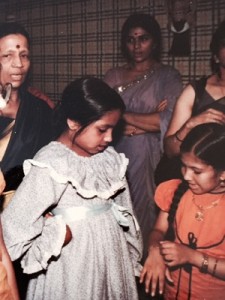
Chitra Ganesh is a South Asian American visual artist who has earned accolades and awards and exhibited her bold and inventive work all over the world. She’s also one of my oldest friends. Not only did we share many common experiences of a desi upbringing in New York City, our mothers were also high school classmates in Calcutta.
Chitra’s current exhibit at the Brooklyn Museum, Eyes of Time, brings the Brooklyn native full circle, so it seemed like the perfect moment to talk to her about how childhood experiences shaped her work and outlook as an artist.
Kavita Das: We both grew up in New York City, you in Brooklyn, I in Queens. When I think back on memories of my Indian American childhood, some indelible images come to mind: celebrating childhood birthday parties at home with Carvel ice cream cake, dressing up in pattu silk pavades for cultural events, like Tamil Sangam and Pongal, reading Amar Chitra Kathas while shuffling between Bharatanatyam dance, Carnatic singing and violin lessons, celebrating religious holidays at the Hindu Temple in Flushing, playing silly games, not in green parks but on sidewalks and concrete school yards.
What about you? What images conjure up your Indian American childhood in New York City?
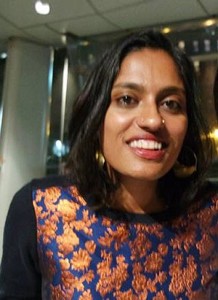
Chitra Ganesh: Your memories conjure many of my own: Bengali Thanksgiving in Sheepshead Bay (Brooklyn) with tomato chutney & boondi raita, being the chubby, uncoordinated one dancing off rhythm at the back of our Bharatanatyam classes, holing up in the Flushing and Jamaica Public libraries, Durga Puja in Jersey City, Carnatic music concerts arranged in the basements of family friends’ homes, the ubiquitous styrofoam cup from which we sipped room temperature Coke, using a lota at home, lots of scraped knees from rough sidewalk play, and, of course, coming to play at your house in Bayside (Queens). It’s a highly charged list that could go on forever.
KD: As you well know, both my parents are physicians and both my siblings are physicians too. I only narrowly escaped becoming a doctor through some good scheming in college. Your father worked in banking and your mother first worked for the City but later turned to teaching. You showed great artistic promise from a young age but how did you chart your path as an artist? Who and what were some early inspirations and influences that let you know that it was possible to make a life as an artist?
CG: My parents always encouraged my interest in art. At age six, they took me to Saturday morning art classes at the back of a real estate office on Utopia Parkway in deep Queens where I learned still life with pastels, amidst a sea of Farah Fawcett-coiffed Queens girls. But as you know, the idea of pursuing art as a profession in our community was just non-existent. The closest thing to role models were Carnatic musicians who came to perform, aunties who taught dance, mothers who knitted for newborns in the community, pattis who drew intricate kolams from memory, and uncles who painted at night after mind-numbing civil service jobs.
Around age ten I began to notice artists like Keith Haring and Frida Kahlo who were doing as they pleased in their wild, energized pictures. Jaminida, one of my father’s very close friends, also shared exhibition postcards from art shows in SoHo and books on Matisse with me. And my parents would bring small, spiral bound contemporary artist monographs published in Delhi by the Lalit Kala Academy — precious, as they were the only access I had to modern and contemporary Indian art in the 80s and early 90s.
“It took me a minute to turn on the flashlight and find my own path.”
It took me a minute to turn on the flashlight and find my own path. During college, I was with peers who were artists, and started to see this path in flesh and blood. Experiencing contemporary art in person (pre-internet times!) was huge. For example, my heart jumped when I saw Rina Banerjee’s and Robert Colescott’s works at the Queens Museum in the early 1990s. Now, I pause with gratitude when desi friends and colleagues tell me, “I showed your website to my teenage daughter and she loved it.”
KD: You have an interesting way of referencing, subverting, or emphasizing Indian traditions and beliefs in your work — from traditional kolam designs, to Indian mythologies, to Amar Chitra Kathas, which themselves are interesting interpretations and curations of Indian culture. How did you experience these Indian traditions and beliefs as a child? What led you to draw upon them as an artist?
CG: Both Amar Chitra Katha (ACK) and kolams were everyday visual references, which existed both at home in NYC and on summer trips to India. Their simultaneous appearance in both places bridged two distinct and equally important geographies of my childhood. You are so right — ACK is very much a curated selection — and like many encyclopedic collections, reveals its nationalist politics, priorities and intent through repeating certain story lines while ignoring others.
It was fascinating to read more on the history of ACK, including Nandini Chandra’s The Classic Popular: Amar Chitra Katha, 1967-2007, in tandem with Scott McCloud’s Understanding Comics, a brilliant semiotic deconstruction of comics. Through Chandra’s book, I learned that there were initially close to 500 ACK stories, which were eventually culled down to 100 comics. I learned, for example, there were even ACK stories featuring dalit heroes — something that I never once saw as a young ACK reader. Often, information was presented as timeless, transhistorical, and authentic, especially in a form seen to be as benign as comics, but actually came with its own arguments, prescribed codes of conduct that maintain hierarchies of gender, skin color, and caste among others.
“I feel how potent a collectively shared set of visual images can be when they are reconsidered.”
I draw on these images because I feel how potent a collectively shared set of visual images can be when they are reconsidered. These comic fragments were submerged in my deeper memory banks, and haunting in ways I couldn’t understand until I saw them again with adult eyes. Some gave me a sense of belonging and comfort, others I experienced as irrelevant and questioned — it was a range of experiences.
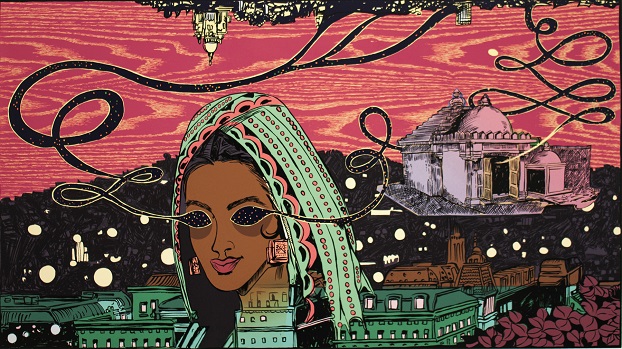
KD: There comes a point in most people’s lives where we become more critical and objective about not only ideas out in the world but those close to us, those from our own culture. For example, one of the recurring themes in your work is gender, and specifically gender roles, femininity in Indian mythology and visual representations of women. How have your thoughts evolved on this and how do you explore this in your work?
CG: I‘m fascinated by the endlessly shape-shifting potential of femininity, which I play with by multiplying, doubling, and fragmenting female bodies in my work. In part because I was an only child, and also because my parents had some consciousness around gender, I feel fortunate in that I did not experience a disparity between the way I was raised in relation to say, siblings or even male cousins.
But the most significant critical reframing of cultural practice came by learning about the history and prevalence of caste based discrimination through alternative historiographies of modern South Asia. I realize that everything I had understood as “Indian culture” up till that point in my diasporic upbringing was actually a narrow strain of practices experienced through a Hindu and Brahmanical lens. Such a notion of a monolithic “Indian culture” is of course non-existent. For example, I remember being shocked and embarrassed when I learned that dalit people are not allowed to enter Hindu temples because of their “untouchable” status, and haven’t been for centuries. Growing up, the caste system was not presented to me within an anti-caste framework.
“I realize that everything I had understood as ‘Indian culture’ up till that point in my diasporic upbringing was actually a narrow strain of practices experienced through a Hindu and Brahmanical lens.”
Looking back, I find it odd considering that my parents had a vocal anti-racist position, vis-a-vis discrimination in the US. I remember lively debates between family friends in which my mom would challenge an uncle or auntie’s anti-black racism. Terms like Brahmin versus non-Brahmin were used to delineate or describe a family friend’s origins, but at the same time, my parents had an unusually diverse group of friends, including very close Sri Lankan Tamil and Pakistani Muslim friends, and supported intercaste marriage amongst their friends and family.
KD: Your current exhibit, Eyes of Time, at the Brooklyn Museum combines a magnificent mural of Hindu Goddess Kali with several art objects that you curated from the Museum’s broader collection that cross mediums, aesthetic styles, and cultures. What narrative were you seeking to create and what do you want the viewer to take away from the juxtaposition of these art objects?
CG: I wanted to use the Museum’s massive collection of objects across period, medium, and era to gesture towards a lineage and art historical context specific to my work. These juxtapositions include a vibrant psychedelic print of Barbara Jones Hogu, an African American artist working out of Chicago in the 1960s, and a figurine of Sekhmet, the Egyptian goddess of fertility, menstruation, and war, which dates back to circa 600 BCE. Curating these objects let me pry open and rearrange objects from an existing visual archive to reveal that there have been complex and powerful representations of the feminine all along, as a thread that has always run through the history of art.
KD: As we both grew up with the Flushing Hindu Temple as a central cultural and religious space — we attended countless religious services above ground, and we attended and participated in many cultural programs in the auditorium below ground. The longtime head of the Temple was recently quoted in the media saying that your portrayal of Goddess Kali was “wrong” and “insulting.” It’s important to note that she hadn’t seen the mural in person because she hadn’t visited the exhibit. Criticism is a natural part of creating and sharing art, but how did this criticism strike you?
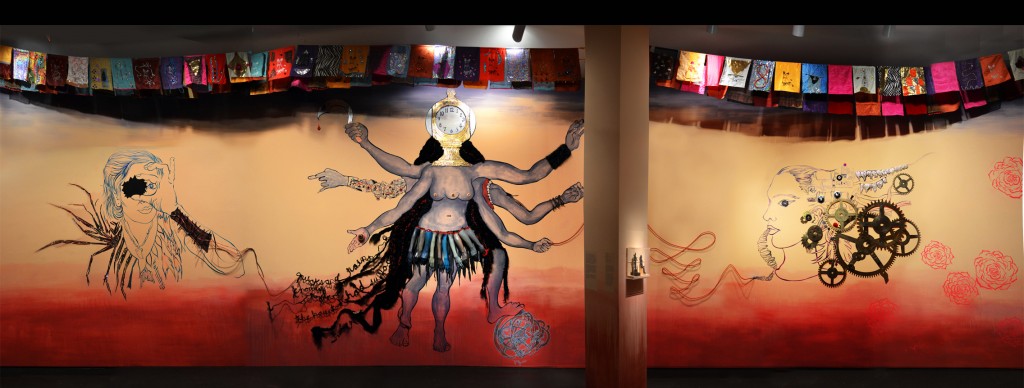
CG: We live in particularly conservative times, provoking a lean into censorship and a manufactured “return to tradition” that cuts across religion and culture. A key strategy for perpetuating this repressive agenda is policing representations of femininity and female sexuality. This is not specific to an Indian outlook — images of menstruation (Rupi Kaur) or women breastfeeding are routinely flagged and removed from social media for obscene content, as Purvi Patel serves a twenty year sentence in jail, and all of it is connected.
The criticism to my piece was itself vague, and failed to mention what exactly was offensive about the material. The rise to power of the Modi government has emboldened voices that express this kind of conservative backlash, around who does or does not have the right to access or reinterpret imagery that is partly Hindu in origin both in India and in the diaspora — Kali also exists in varied forms within Buddhist mythologies as well.
Riffing on your memories of our times at the Ganesh Temple in Flushing, — spending Shivratris in my mom’s godhi there, attending my parent’s friends first, and in some cases, second marriages there, eating at Dosa Hutt, to performing a portion of my own mother’s death rites there, — I found the suggestion that my interpretation came out of ignorance and lack of connection to the cultural milieu, ironic.
KD: Brooklyn was your childhood home and continues to be where you call home. I imagine that over the years you must have made many, many trips to the Brooklyn Museum. How does it feel to have an exhibit there?
CG: Yes! I visited the Egyptology section in middle school, took a watercolor class on Sundays there when I was 13, conducted a workshop with youth as an art educator, flirted and people-watched on first Saturdays as a twenty-something, and continue to view museum exhibitions regularly. I feel incredibly lucky.
KD: Your father and stepmother make their home in Brooklyn, very close to the Museum — they must be very proud.
CG: They are wonderfully proud and supportive. Their profound love and generosity manifests in a radical acceptance of who I am, and this is precious. After all, I am a far cry from the Ivy League educated Tambram daughter who by now could have had a high-powered career in law or corporate America, — much like the around the way homeboys I grew up with do now — as well as a husband and a kid or two.
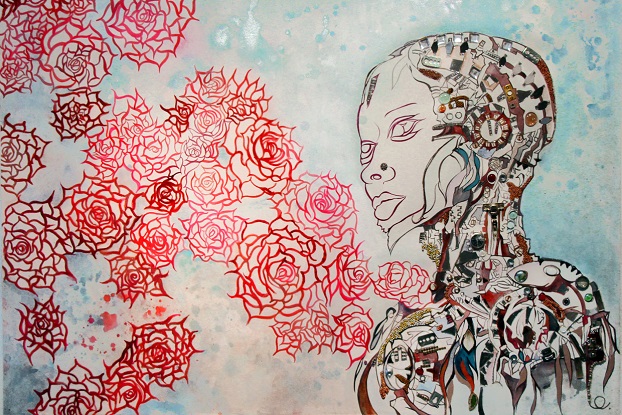
KD: Going to the other side of the globe, you’ve had several exhibits in India over the last few years. As an Indian American artist, what has that experience been like? Was there anything that surprised you?
CG: It has been an amazing experience to exhibit and make my work in India. Specifically, I feel liberated from the burden of having the “Indianness” of my work be the primary lens of interpretation; my work is able to breathe differently and transmit via other channels, and can be approached and engaged as being, for example, about temporality, iconicity, science fiction, nostalgia, or mark making rather than being placed primarily within an identitarian context.
“…I feel liberated from the burden of having the ‘Indianness’ of my work be the primary lens of interpretation…”
The contemporary art scene in South Asia is vibrant, complex, intellectually very rich, and free of some of the identitarian constraints that accompany thinking about how categories such as gender, culture, or history are constructed within and constrained by an American framework of race. There is an incredibly robust movement based feminism and queer rights discourse in India that really enhances the readings of my work, and provide other points of entry outside of Western feminism. I’ve also met a number of young artists, art writers, and curators who are doing incredibly exciting work that the world is going to be amazed by, if not already!!
KD: Art is often a solitary pursuit, and you have a large body of work as a solo artist. You have also collaborated with many other artists, including the Index of the Disappeared exhibit and conference with fellow artist Mariam Ghani, What Remains with filmmaker Sarita Khurana, and Rabbithole, animated by you and scored by composer/tabla player Karsh Kale. Can you describe those experiences and talk about what you seek in an artistic collaboration?
CG: Collaboration has been a key aspect of my creative practice and artistic growth over the past several years. It’s been very liberating as a place to experiment, take risks, explore aesthetics that are widely varied from our own, and elaborate on a new set of issues and processes that are compelling to both artists.
My most significant collaboration has been with artist, colleague and dear friend Mariam Ghani, with whom I have been working on the Index of the Disappeared since 2004. Index of the Disappeared is both a physical archive of post-9/11 disappearances — detentions, deportations, renditions, redactions — and a platform for public dialogue around related issues. The Index also produces visual and poetic interventions that circulate fragments of the archive in the wider world, including exhibitions, conferences, text-based works, public installations, and commissioned web projects.
My work with artists Sarita Khurana, Simone Leigh, and Christopher Myers has also yielded meaningful experiments with form collaborations across media. And Karsh Kale was generous enough to allow me the possibility of mixing and using a number of his tracks for the sounds accompanying my animation Rabbithole, though the idea and development of the animation and sounds were not a collaboration as such.
KD: I read that when you were doing your MFA, there was little or no focus on South Asian art. And even then, the focus would only be on ancient artwork rather than contemporary South Asian art. Now, you’re not only creating South Asian art, you’re teaching courses about it. Tell me more about this.
CG: Well, contemporary art from the (Indian) subcontinent was barely visible in mainstream contemporary art within the US then. This has definitely changed since, albeit very slowly. What I learned of contemporary South Asian art happened on my own, and with my peers in the desi community outside of school who shared these interests.
This past fall, I had the opportunity to teach a graduate level course on contemporary South Asian Art as the first Kirloskar Scholar, an endowed position at the Rhode Island School of Design dedicated to integrating contemporary art from the Indian subcontinent into the curriculum. It was an amazing experience to teach about the work of peers and role models to a very diverse and talented group of students.
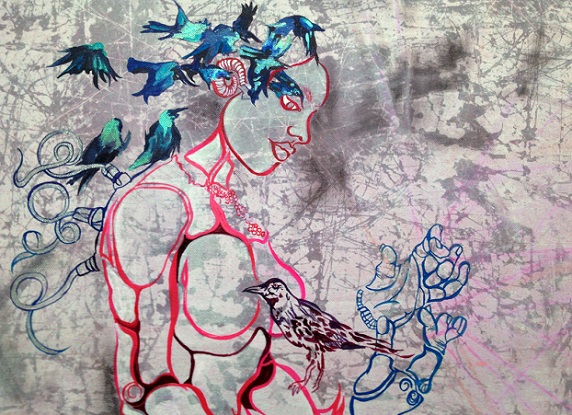
KD: So, your life and trajectory as an artist intersects with seminal moments in the growth of South Asian American cultural spaces — from South Asian Women’s Creative Collective (SAWCC), which you were on the board of at one point, to the rise of Basement Bhangra and DJ Rekha, whom you count as a close friend. And much of this desi goodness was in effect at a recent event celebrating the Eyes of Time. What did that mean to you?
CG: I cherish the progressive desi spaces that I first encountered in the late 1990s, which grew me up and have supported my work for almost twenty years now. SAWCC (South Asian Women’s Creative Collective) and Basement Bhangra were at the center of this, as well as SALGA (the South Asian Lesbian and Gay Association) and YSS (Youth Solidarity Summer), which evolved into an informal network of committed desi leftists and cultural producers. Listening to Drum and Bass at Mutiny, a club night hosted by DJ Rekha and Vivek Bald, seeing amazing drag performances choreographed to classic Bollywood songs at SALGA parties, and exhibiting my work with SAWCC, were all critical to shaping my own work and creative community.
In these spaces I encountered for the first time the possibility that desi people could follow their commitment to photography, contemporary art, anthropology, and pop music, among other disciplines, which children of immigrants are generally not encouraged to pursue. Many of the people who emerged from these spaces are now nationally and internationally recognized artists, journalists, activists, and filmmakers who I feel really lucky and proud to have come of age with. These spaces continue to pave the way for the younger generation as well, who hopefully see a much more visible creative community than what we remember from 25 years ago.
* * *
Chitra Ganesh’s exhibit, Eyes of Time, is on display at the Brooklyn Museum through July 12, 2015.
Kavita Das worked in the social change sector for 15 years on issues ranging from homelessness to health disparities to most recently, racial justice. She now writes about cross-cultural issues and is working on a biography about Grammy-nominated Hindustani singer Lakshmi Shankar. Find her on Twitter @kavitamix.













1 thought on “Drawing Inspiration: A Conversation With Visual Artist Chitra Ganesh”
Comments are closed.